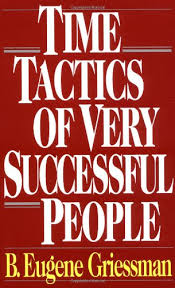
Premise:
The premise of “Time Tactics of Very Successful People”, is that we all have 24 hours in a day and that successful people and unsuccessful people all receive the same amount of time every day. The difference between successful people and unsuccessful people is how they utilize the 24 hours a day they have been given in a way that produces results and creates value. Time management is a skill that you must master to be successful; however, no one can actually manage time because time will march on whether we focus on it or not. What we can manage is our activities in a discipline and consistent manner that over time will deliver the outputs and outcomes we desire and enable us to accomplish more in a week than most people accomplish all year.
What I learned:
- Spend time every day organizing your to-do list. Once you have a complete list, you want to ABC your priorities and determine the most critical tasks to complete that day. This becomes your A1 task. Brian Tracy refers to this activity as eating the ugliest frog first in his best-selling book, “Eat That Frog”.
- Assign a billable hourly rate to your time and determine if the activity you are planning to complete is aligned with your billable rate. If the activity you are planning to accomplish can be delivered by someone at a lesser bill rate than your assigned rate, you should delegate that activity. Good examples of this tactic are:
- Completing administrative tasks
- Bookkeeping activities
- Changing the oil in your car
- Mowing your lawn.
- Apply the 80/20 rule or the Pareto principle to everything you do.
- Write out your to-do list on paper by hand. This exercise reinforces and strengthens the neural connections in your brain to remember your to-do list more clearly. At the end of the day, whatever you did not accomplish, rewrite your lists at night. This will allow your subconscious to figure out better ways to accomplish your activities and it will also give you new ideas that you have not considered before.
- Create templates and checklists for your repeatable activities. If you have a sales or marketing email that you send consistently, make it into a template. If you have an activity that has multiple steps that you repeat on a regular basis, make a checklist and use the checklist in the same way a pilot uses a preflight checklist. Both of these activities will save you an enormous amount of time in accomplishing repeatable activities.
- Use the piggyback principle. The piggyback principle can be applied for when you give a speech and modify that speech for another opportunity for when you have a collection of writings that you combine and edit into a new work.
- Learn to make the most of your time between meetings and also look for any time wasters in your schedule. Find 10 minutes time slots and make follow up phone calls.
- Always carry a journal to keep track of new ideas.
Conclusion:
In conclusion, if you spend 30 minutes a day reading and reviewing the many ideas available in this book, you will be investing time that in the short and long run will save you many hours and days of time. This book can be summed up with the quote, “If I had eight hours to chop down a tree, I'd spend six hours sharpening my axe." Learning the time saving techniques outlined in this book is a great way to sharpen your time management axe.
Principles of Execution Key Concepts:
- Very Successful People
- Piggyback Principle
- Pareto Principle
Share your ideas or thoughts!
